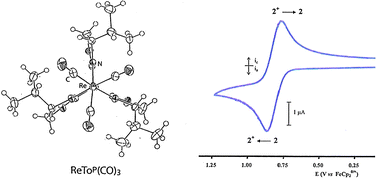M(CO)3 (M = Mn, Re) complexes of two tris(oxazolinyl)phenylborate ligands (ToM and ToP) have been prepared and characterized by spectroscopic, electrochemical and crystallographic methods. The steric bulk imparted by the sp3-hybridized carbons in the oxazoline ring gives the tris(oxazolinyl)borate ligands significant structural protection against dimerization while leaving the M(CO)3 face open for possible reactivity. The anodic electrochemistry of these systems in relatively benign media showed that their one-electron oxidation products were stable and persistent in the case of Re, but of limited stability in the case of Mn. The anodic oxidation of Mn and Re complexes of four tris(pyrazolyl)borate (Tp and Tp*) ligands was also investigated, once again showing that the radical cations of the Re complexes were longer lived than their Mn congeners in CH2Cl2/[NBu4][B(C6F5)4]. The E1/2 data were used to classify the electron-donating properties of the different scorpionate ligands in comparison with their cyclopentadienyl counterparts as Tp* > Cp* > ToP, Tp, ToM > Cp. Comparison of the νCOIR frequencies of these complexes gave a slightly different sequence of donor strength, Cp*, ToM, ToP > Tp* > Tp > Cp. The electronic effects of the tris(oxazolinyl)phenyl borate ligands are that they convey “Tp*-like” character in terms of the chemical reactivity of their complexes, and “Tp-like” character in terms of the redox potentials of these complexes.

You have access to this article
 Please wait while we load your content...
Something went wrong. Try again?
Please wait while we load your content...
Something went wrong. Try again?


 Please wait while we load your content...
Please wait while we load your content...